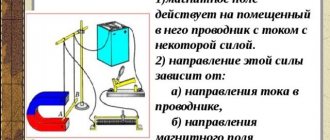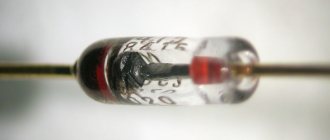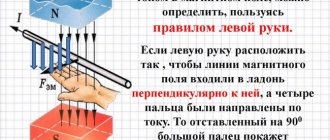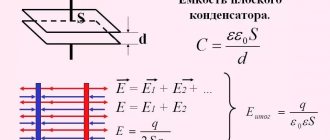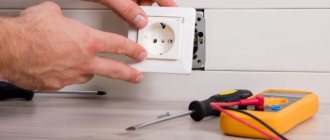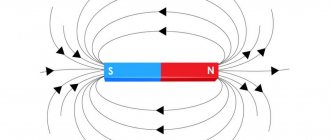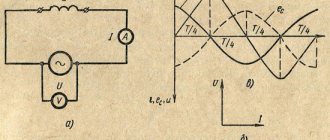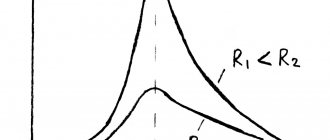The phenomenon of electromagnetic induction
Electromagnetic induction is the phenomenon of the occurrence of current in a closed conductive circuit when the magnetic flux passing through it changes.
The phenomenon of electromagnetic induction was discovered by M. Faraday.
Faraday's experiments
- Two coils were wound on one non-conducting base: the turns of the first coil were located between the turns of the second. The turns of one coil were closed to a galvanometer, and the second was connected to a current source. When the key was closed and current flowed through the second coil, a current pulse arose in the first. When the switch was opened, a current pulse was also observed, but the current through the galvanometer flowed in the opposite direction.
- The first coil was connected to a current source, the second, connected to a galvanometer, moved relative to it. As the coil approached or moved away, the current was recorded.
- The coil is closed to the galvanometer, and the magnet moves - moves in (extends) - relative to the coil.
Experiments have shown that induced current occurs only when the magnetic induction lines change. The direction of the current will be different when the number of lines increases and when they decrease.
The strength of the induction current depends on the rate of change of the magnetic flux. The field itself may change, or the circuit may move in a non-uniform magnetic field.
Explanations of the occurrence of induction current
Current in a circuit can exist when external forces act on free charges. The work done by these forces to move a single positive charge along a closed loop is equal to the emf. This means that when the number of magnetic lines through the surface limited by the contour changes, an emf appears in it, which is called the induced emf.
Electrons in a stationary conductor can only be driven by an electric field. This electric field is generated by a time-varying magnetic field. It is called an eddy electric field . The concept of a vortex electric field was introduced into physics by the great English physicist J. Maxwell in 1861.
Properties of the vortex electric field:
- source – alternating magnetic field;
- detected by the effect on the charge;
- is not potential;
- the field lines are closed.
The work of this field when moving a single positive charge along a closed circuit is equal to the induced emf in a stationary conductor.
Magnetic induction lines
A clear picture of the magnetic field can be obtained by constructing the so-called magnetic induction lines. Magnetic induction lines are lines whose tangents at any point coincide with the vector at a given point in the field (Fig. 1.10). The lines of the magnetic induction vector are similar to the lines of the electrostatic field strength vector.
For the magnetic field of a straight conductor with current, from the previous experiments it follows that the lines of magnetic induction are concentric circles lying in a plane perpendicular to this conductor with current (see Fig. 1.9). The center of the circles is on the axis of the conductor. The arrows on the lines indicate in which direction the magnetic induction vector tangent to a given line is directed.
Figure 1.11 shows the magnetic field pattern of a current-carrying coil (solenoid). If the length of the solenoid is much greater than its diameter, then the magnetic field inside the solenoid can be considered uniform
.
The magnetic induction lines of such a field are parallel
and located at equal distances from each other.
Figure 1.12 shows the Earth's magnetic field. The Earth's magnetic field lines are similar to the magnetic field lines of a solenoid. The magnetic north pole N is close to the geographic South Pole, and the magnetic south pole S is close to the geographic North Pole. The axis of such a large magnet makes an angle of 11.5° with the axis of rotation of the Earth. Periodically, the magnetic poles change their polarity. The last such replacement occurred about 30,000 years ago.
The pattern of magnetic induction lines can be made visible by using fine iron filings. You are already familiar with this method.
In a magnetic field, each piece of iron poured onto a sheet of cardboard becomes magnetized and behaves like a small magnetic needle. A large number of such arrows allows you to determine the direction of the magnetic field at a larger number of points and, therefore, more accurately determine the location of the magnetic induction lines. Examples of magnetic field patterns are shown in Figures 1.13—1.16.
Magnetic flux
Magnetic flux through the area \( S \) of the contour is called a scalar physical quantity equal to the product of the magnitude of the magnetic induction vector \( B \), the surface area \( S \), penetrated by this flux, and the cosine of the angle \ ( \alpha \) between the direction of the magnetic induction vector and the normal vector (perpendicular to the plane of a given surface):
The designation is \( \Phi \), the SI unit is weber (Wb).
A magnetic flux of 1 weber is created by a uniform magnetic field with an induction of 1 T through a surface of 1 m2 located perpendicular to the magnetic induction vector:
Magnetic flux can be visualized as a value proportional to the number of magnetic lines passing through a given area.
Depending on the angle \( \alpha \) the magnetic flux can be positive (\( \alpha \) < 90°) or negative (\( \alpha \) > 90°). If \( \alpha \) = 90°, then the magnetic flux is 0.
You can change the magnetic flux by changing the area of the circuit, the field induction module, or the location of the circuit in the magnetic field (by rotating it).
In the case of a non-uniform magnetic field and a non-flat contour, the magnetic flux is found as the sum of the magnetic fluxes penetrating the area of each of the sections into which a given surface can be divided.
Magnetic induction lines
Magnetic induction lines are lines whose tangents are directed in the same way as the vector at a given point in space (Fig. 4.22).
Let's construct magnetic induction lines for the magnetic field of a straight conductor carrying current. From the previous descriptions of experiments with a contour and a magnetic needle, as well as from considerations of symmetry, it follows that the lines of magnetic induction in this case are concentric circles lying in a plane perpendicular to this current-carrying conductor. The center of the circles is on the axis of the conductor (Fig. 4.23). As in the case of electric field strength lines, magnetic induction lines can be arranged to be drawn so that their density characterizes the magnitude of vector B in a given location. In Figure 4.23, the concentric circles are condensed towards the center. This should mean that the magnetic induction near the wire is greater than far from it.
The picture of the magnetic induction lines of a current-carrying coil (solenoid) is shown in Figure 4.24 (the solenoid is shown in section). If the length of the solenoid is much greater than its diameter, then the field inside the solenoid can be considered uniform. The lines of magnetic induction of such a field are parallel, their density is the same everywhere.
The pattern of magnetic induction lines can be made visible by using fine iron filings. In a magnetic field, each piece of iron sprinkled on a sheet of cardboard becomes magnetized and behaves like a small magnetic needle. The presence of such a large number of arrows makes it possible to determine the direction of the magnetic induction vector of the magnetic field at a large number of points and, therefore, more accurately determine the location of the induction lines. Some of the magnetic field patterns are shown in Figures 4.25-4.28.
Faraday's law of electromagnetic induction
Law of electromagnetic induction (Faraday's law):
The induced emf in a closed loop is equal and opposite in sign to the rate of change of the magnetic flux through the surface bounded by the loop:
The “–” sign in the formula allows you to take into account the direction of the induction current. The induced current in a closed circuit always has such a direction that the magnetic flux of the field created by this current through the surface bounded by the circuit would reduce those changes in the field that caused the appearance of the induced current.
If the circuit consists of \( N \) turns, then the induced emf:
The strength of the induction current in a closed conductive circuit with resistance \( R \):
When a conductor of length \( l \) moves with a speed \( v \) in a constant uniform magnetic field with induction \( \vec{B} \) the emf of electromagnetic induction is equal to:
where \( \alpha \) is the angle between the vectors \( \vec{B} \) and \( \vec{v} \).
The occurrence of induced emf in a conductor moving in a magnetic field is explained by the action of the Lorentz force on free charges in moving conductors. The Lorentz force plays the role of an external force in this case.
A conductor moving in a magnetic field through which an induced current flows experiences magnetic braking. The total work done by the Lorentz force is zero.
The amount of heat in the circuit is released either due to the work of an external force, which maintains the speed of the conductor unchanged, or due to a decrease in the kinetic energy of the conductor.
Important! A change in the magnetic flux penetrating a closed circuit can occur for two reasons:
- the magnetic flux changes due to the movement of the circuit or its parts in a time-constant magnetic field. This is the case when conductors, and with them free charge carriers, move in a magnetic field;
- The second reason for the change in the magnetic flux penetrating the circuit is the change in time of the magnetic field when the circuit is stationary. In this case, the occurrence of induced emf can no longer be explained by the action of the Lorentz force. The phenomenon of electromagnetic induction in stationary conductors, which occurs when the surrounding magnetic field changes, is also described by Faraday's formula.
Thus, the phenomena of induction in moving and stationary conductors proceed in the same way, but the physical reason for the occurrence of induction current turns out to be different in these two cases:
- in the case of moving conductors, the induced emf is due to the Lorentz force;
- in the case of stationary conductors, the induced emf is a consequence of the action on free charges of the vortex electric field that occurs when the magnetic field changes.
The direction of the magnetic induction lines is determined by the gimlet (right hand) rule.
| Examples of some magnetic fields | Field lines | Determining the direction of magnetic induction lines |
| Forward current field | Direct current magnetic induction lines are concentric circles lying in a plane perpendicular to the current. | The thumb of the right hand is directed along the current in the conductor, four fingers are wrapped around the conductor, the direction in which the fingers are bent coincides with the direction of the magnetic induction line. |
| Circular current field | The four fingers of the right hand grasp the conductor in the direction of the current in it, then the bent thumb will indicate the direction of the magnetic induction line. | |
| Solenoid field (coils with current) | The end of the solenoid from which the magnetic induction lines come out is its north magnetic pole, the other end into which the induction lines enter is its south magnetic pole. | It is determined similarly to the circular current field. |
A magnetic field is detected by its effect on current-carrying conductors or a moving charged particle.
| Ampere power | Lorentz force | |
| Definition | The force with which a magnetic field acts on a current-carrying conductor. | The force that a magnetic field exerts on a moving charged particle. |
| Formula | ||
| Direction | Left hand rule: if the left hand is positioned so that the magnetic induction lines enter the palm, the four extended fingers are directed along the current, then the thumb bent 90 degrees will indicate the direction of the Ampere force. | Left hand rule: if the hand is positioned so that the magnetic induction lines enter the palm, the four extended fingers are directed in the direction of movement of the positively charged particle, then the thumb bent 90 degrees will indicate the direction of the Lorentz force. |
| Work of force | ,where is the angle between the vectors and . | The Lorentz force does not do work on the particle and does not change its kinetic energy; it only bends the trajectory of the particle, giving it centripetal acceleration. |
The nature of the movement of charged particles in a magnetic field.
1) A particle with a charge enters a magnetic field so that the vector is parallel, in this case, the particle moves rectilinearly and uniformly.
2) A particle with a charge enters a magnetic field so that the vector is perpendicular, in this case the particle moves in a circle in a plane perpendicular to the induction lines.
3) A particle with a charge enters a magnetic field so that the vector makes a certain angle with the vector, in this case the particle moves in a spiral.
AN EXAMPLE OF SOLVING THE PROBLEM ON THE MOTION OF A CHARGED PARTICLE IN A MAGNETIC FIELD
An electron moves in a uniform magnetic field with induction 4. Find its period of revolution.
Answer: 8.9
From the formula obtained when solving the problem, it follows that the period of revolution of a charged particle in a magnetic field does not depend on the speed with which it flies into the magnetic field and does not depend on the radius of the circle along which it moves.
Content
ELECTROMAGNETIC INDUCTION
Electromagnetic induction is the phenomenon of the occurrence of induced emf in a conductive circuit located in a changing magnetic field. If the conductive circuit is closed, then an induced current arises in it.
LAW OF ELECTROMAGNETIC INDUCTION (FARADAY'S LAW): The induced emf is equal in magnitude to the rate of change of magnetic flux.
or , where is the number of turns in the circuit, magnetic flux.
The minus sign in the law reflects Lenz's rule: the induced current, with its magnetic flux, prevents a change in the magnetic flux that causes it .
, where is the surface area of the contour, the angle between the magnetic induction vector and the normal to the plane of the contour.
, where is the inductance of the conductor.
Inductance depends on the shape and size of the conductor (the inductance of a straight conductor is less than the inductance of the coil), and on the magnetic properties of the environment surrounding the conductor.
| Methods for obtaining induced emf | Formula | The nature of outside forces | Determining the direction of induction current |
| The conductor is in an alternating magnetic field | , Where | A vortex electric field that is generated by a changing magnetic field. | Algorithm: 1) Determine the direction of the external magnetic field. 2) Determine whether the magnetic flux is increasing or decreasing. 3) Determine the direction of the magnetic field of the induction current. If >0, then, if <0, then 4) Using the rule of the gimlet (right hand), determine the direction of the induction current. |
| The contour area changes | , Where | ||
| The position of the circuit in the magnetic field changes (the angle changes) | , Where | ||
| A conductor moves in a uniform magnetic field | , , where is the angle between | Lorentz force | Rule of the right hand: if the palm is positioned so that the vector of magnetic induction enters the palm, the outstretched thumb coincides with the direction of the conductor’s speed, then four outstretched fingers will indicate the direction of the induction current. |
| Self-induction is the phenomenon of the occurrence of induced emf in a conductor through which a changing current flows. | or | Vortex electric field | The self-induction current is directed in the same direction as the current created by the source, if the current strength decreases, the self-induction current is directed against the current created by the source, if the current strength increases. |
Example of using the algorithm:
When solving problems on electromagnetic induction, Ohm's law is used: , and .
MAGNETIC FIELD ENERGY
VORTEX AND POTENTIAL FIELDS
| Potential fields: gravitational, electrostatic | Vortex (non-potential) fields | ||
| magnetic | vortex electric | ||
| Field Source | Fixed electric charge | Moving charge (electric current) | Changing magnetic field |
| Field indicator (an object on which the field acts with some force) | Electric charge | Moving charge (electric current) | Electric charge |
| Field lines | Open lines of electric field strength begin on positive charges | Closed lines of magnetic induction | Closed lines of tension |
Properties of potential field forces:
1) The work of potential field forces does not depend on the shape of the trajectory, but is determined only by the initial and final position of the body.
2) The work done by the potential field forces when moving a body (charge) along a closed path is zero.
3) The work done by the potential field forces is equal to the change in the potential energy of the body (charge), taken with a minus sign.
Content
ELECTROMAGNETIC OSCILLATIONS
Electromagnetic oscillations are periodic changes in charge, current, and voltage.
— formula for calculating the period of electromagnetic oscillations (Thomson formula).
FREE ELECTROMAGNETIC OSCILLATIONS occur in an oscillatory circuit consisting of an inductive coil and a capacitor. In order for oscillations to occur in the circuit, the capacitor must be charged, giving it a charge.
| Charge |
| Current strength |
| Voltage |
| Electric field energy |
| Magnetic field energy |
| Total Energy |
An ideal oscillatory circuit is a circuit whose resistance is zero. In real circuits, therefore, the oscillations die out, the energy initially imparted to the circuit turns into heat.
FORCED ELECTROMAGNETIC OSCILLATIONS (ALTERNATING CURRENT)
Alternating current can be obtained by rotating a conducting frame in a magnetic field. In this case, the magnetic flux will change according to the law of sine or cosine.
Instantaneous value of induced emf in the circuit
where is the maximum value of the induced emf if the frame contains turns, then
The effective value of voltage and strength of alternating current is the voltage and strength of such a direct current at which the same amount of heat is released in the circuit as with a given alternating current.
Voltmeters and ammeters connected to an alternating current circuit measure effective values.
AC LOADS
| Load | Characteristic phenomenon | Current strength, voltage | Ohm's law |
| Active load | An irreversible conversion of electrical energy into heat occurs. | The current and voltage fluctuations are in phase. | active resistance. |
| Capacity | The capacitor is periodically charged and discharged. | Current fluctuations are ahead of voltage fluctuations by | capacitance. |
| Inductance | The self-induced emf prevents the current from changing in the coil. | Current fluctuations lag behind voltage fluctuations by | inductive reactance. |
RESONANCE IN AN ELECTRIC CIRCUIT is a sharp increase in the amplitude of fluctuations in current and voltage when the frequency of the alternating current supplied to the circuit coincides with the natural frequency of the circuit. Resonance is possible if a circuit containing inductance and capacitance and having a natural oscillation frequency , which depends only on and , is connected to an alternating current circuit with a frequency and Resonant frequency
At resonance
TRANSFORMER - a device that converts alternating current of one voltage into alternating current of another voltage without changing the frequency. Consists of primary and secondary coils mounted on a closed core. The primary coil contains the number of turns and is connected to the AC source, the secondary coil contains the number of turns and is connected to the electrical consumer.
Transformation ratio
By increasing the voltage several times, the transformer reduces the current by the same amount:
They increase the voltage and correspondingly decrease the current when transmitting energy from power plants to the consumer in order to reduce heat losses on the power line wires, then they obtain the voltage necessary for the consumer using step-down transformers.
Content
ELECTROMAGNETIC WAVES
An electromagnetic wave is an electromagnetic field propagating in space. The theory of electromagnetic waves was created by J. Maxwell in the 60s of the 19th century:
1) An alternating magnetic field generates an alternating electric field, an alternating electric field generates an alternating magnetic field, etc. This process lies in the formation of an electromagnetic wave.
2) The source of the electromagnetic wave is an oscillating (accelerating) charge.
3) An electromagnetic wave in a vacuum propagates at the speed of light
4) Electromagnetic waves are transverse. Oscillations of vectors and occur in mutually perpendicular planes, which are perpendicular to the direction of the speed of wave propagation, i.e. mutually perpendicular.
5) The oscillations of the vectors and coincide in phase, that is, they simultaneously turn to zero and simultaneously reach a maximum.
6) Electromagnetic waves can be reflected, refracted, they are characterized by the phenomena of interference, diffraction, dispersion, polarization.
Electromagnetic waves were first discovered by the German physicist Heinrich Hertz in 1887. In his experiments, Hertz used an open oscillatory circuit, which was a piece of metal conductor (antenna or Hertz vibrator).
PRINCIPLES OF RADIO COMMUNICATION
Radio communication is the transmission of information using electromagnetic waves.
RADIO TRANSMITTER
| Elements | Purpose |
| Microphone | Converts sound vibrations into low-frequency electromagnetic vibrations, which carry information but are not emitted into space. |
| High frequency generator | Creates high-frequency vibrations that can be emitted into space, but do not carry information. |
| Modulator | It changes the parameters of high-frequency oscillations with the help of low-frequency oscillations, waves are created that carry information and can be emitted into space. |
| Transmitting antenna | Emits modulated vibrations into space |
RADIO
| Elements | Purpose |
| Receiving antenna | In the receiving antenna, electromagnetic waves excite high-frequency oscillations. |
| Variable capacitance oscillatory circuit | Selects from all kinds of electromagnetic oscillations those oscillations whose frequency coincides with the frequency of this circuit. The frequency of the circuit can be changed by changing the capacitance of the circuit. |
| Detector | Selects low-frequency oscillations from modulated high-frequency oscillations. |
| Speaker | Converts low-frequency electrical vibrations into sound vibrations. |
CLASSIFICATION OF RADIO WAVES
| Name | Wavelength range (m) | Properties |
| Long Medium | 10000 – 1000 1000 — 100 | They bend around the earth's surface. Used for radio communication between points located on the Earth's surface beyond line of sight. |
| Short | 100 — 10 | Reflected from the ionosphere and the Earth's surface. Used for radio communication at any distance between two points on Earth. |
| Ultra short | <10 | They penetrate the ionosphere and almost never go around the Earth. Used for radio communication between points within line of sight, for radio communication with spaceships. |
Content
GEOMETRIC OPTICS
LAWS OF GEOMETRIC OPTICS
1) Law of rectilinear propagation of light:
Previous9Next
What to do if there is no reciprocity? And now let's come down from heaven to earth. Have you landed? Let's continue the conversation...
WHAT AND HOW THEY WRITTEN ABOUT FASHION IN MAGAZINES AT THE BEGINNING OF THE XX CENTURY The first issue of the Apollo magazine for 1909 began, in fact, with a policy statement from the magazine’s editors...
WHAT HAPPENS WHEN WE FIGHT Without understanding the differences that exist between men and women, it is very easy to lead to a quarrel...
What Causes Trends in Stock and Commodity Markets Freight Train Theory Explained My first 17 years of market research consisted of trying to figure out when...
Didn't find what you were looking for? Use Google search on the site:
Lenz's rule
The direction of the induction current is determined by Lenz's rule : the induction current excited in a closed loop when the magnetic flux changes is always directed so that the magnetic field it creates prevents the change in the magnetic flux causing the induction current.
Algorithm for solving problems using Lenz's rule:
- determine the direction of the magnetic induction lines of the external magnetic field;
- find out how magnetic flux changes;
- determine the direction of the magnetic induction lines of the magnetic field of the induced current: if the magnetic flux decreases, then they are co-directed with the lines of the external magnetic field; if the magnetic flux increases, it is opposite to the direction of the magnetic induction lines of the external field;
- according to the gimlet rule, knowing the direction of the induction lines of the magnetic field of the induction current, determine the direction of the induction current.
Lenz's rule has a deep physical meaning - it expresses the law of conservation of energy.
Determining the direction of the magnetic induction vector using the gimlet rule
In the early 19th century, scientists discovered that a magnetic field is created around a conductor with current flowing through it. The resulting lines of force behave according to the same rules as with a natural magnet. Moreover, the interaction of the electric field of a conductor with current and the magnetic field served as the basis for electromagnetic dynamics.
Understanding the orientation in space of forces in interacting fields allows us to calculate axial vectors:
- Magnetic induction;
- Magnitude and direction of induction current;
- Angular velocity.
This understanding was formulated in the gimlet rule.
By combining the forward movement of the right-handed gimlet with the direction of the current in the conductor, we obtain the direction of the magnetic field lines, which is indicated by the rotation of the handle.
Not being a law of physics, the gimlet rule in electrical engineering is used to determine not only the direction of the magnetic field lines depending on the current vector in the conductor, but also vice versa, determining the direction of the current in the wires of the solenoid in connection with the rotation of the magnetic induction lines.
Understanding this relationship allowed Ampere to substantiate the law of rotating fields, which led to the creation of electric motors of various principles. All retractor equipment using inductors follows the gimlet rule.
Self-induction
Self-induction is the phenomenon of the occurrence of induced emf in a conductor as a result of a change in current in it.
When the current in the coil changes, the magnetic flux created by this current changes. A change in the magnetic flux passing through the coil should cause the appearance of an induced emf in the coil.
In accordance with Lenz's rule, the self-inductive emf prevents the current from increasing when the circuit is turned on and the current from decreasing when the circuit is turned off.
This leads to the fact that when a circuit is closed in which there is a current source with a constant EMF, the current strength is established after some time.
When the source is turned off, the current also does not stop instantly. The self-inductive emf that arises in this case may exceed the source emf.
The phenomenon of self-induction can be observed by assembling an electrical circuit from a coil with high inductance, a resistor, two identical incandescent lamps and a current source. The resistor must have the same electrical resistance as the coil wire.
Experience shows that when the circuit is closed, an electric lamp connected in series with a coil lights up somewhat later than a lamp connected in series with a resistor. The increase in current in the coil circuit during closure is prevented by the self-induction emf, which occurs when the magnetic flux in the coil increases.
When the power source is turned off, both lamps flash. In this case, the current in the circuit is maintained by the self-induction emf that occurs when the magnetic flux in the coil decreases.
Self-inductive emf \( \varepsilon_{is} \), arising in a coil with inductance \( L \), according to the law of electromagnetic induction is equal to:
The self-inductive emf is directly proportional to the inductance of the coil and the rate of change of current in the coil.
Inductance
Electric current passing through a conductor creates a magnetic field around it. The magnetic flux \( \Phi \) through the loop of this conductor is proportional to the induction modulus \( \vec{B} \) of the magnetic field inside the loop, and the magnetic field induction, in turn, is proportional to the current strength in the conductor.
Therefore, the magnetic flux through the loop is directly proportional to the current in the loop:
Inductance is a coefficient of proportionality \( L \) between the current strength \( I \) in the circuit and the magnetic flux \( \Phi \) created by this current:
Inductance depends on the size and shape of the conductor, on the magnetic properties of the environment in which the conductor is located.
The SI unit of inductance is henry (H). The inductance of the circuit is 1 henry if, at a direct current of 1 ampere, the magnetic flux through the circuit is 1 weber:
We can give a second definition of the unit of inductance: an element of an electrical circuit has an inductance of 1 H if, with a uniform change in the current in the circuit by 1 ampere in 1 s, a self-inductive emf of 1 volt occurs in it.
Image of magnetic induction lines
To visually study the distribution of the field in space, the dimensions of the measuring elements are reduced. Iron filings evenly scattered on the surface of a cardboard sheet or other electrically neutral plane are suitable for the experiment.
Magnetic induction lines - a visual representation of the force field distributionIf you bring a magnet from the reverse side, metal particles, like miniature compass needles, are distributed along the force strips. By the distance between them one can judge the energy parameters of the field in a certain place. Create a drawing in the same way. Greater density (near the poles) indicates an increased value of induction.
We advise you to study Solidly grounded neutral
For your information. Physically separating a permanent magnet into parts will not create separate poles. This is a fundamental difference from electrostatic charges of a certain polarity, which also create a force field.
The presented knowledge is used to solve various engineering problems. In particular, simple rules for determining the direction of current in a conductor and the direction in which the solenoid core moves are useful.
Magnetic levitation train accelerates to high speeds with minimal energy losses
Basic formulas of the section “Electromagnetic induction”
Algorithm for solving problems on the topic “Electromagnetic induction”:
1. Carefully read the conditions of the problem. Establish the reasons for the change in the magnetic flux penetrating the circuit.
2. Write down the formula:
- law of electromagnetic induction;
- induced emf in a moving conductor, if the problem considers a progressively moving conductor; If the problem considers an electrical circuit containing a current source and an induced emf arising in one of the sections, caused by the movement of a conductor in a magnetic field, then you first need to determine the magnitude and direction of the induced emf. After this, the problem is solved by analogy with problems for calculating a direct current circuit with several sources.
3. Write down an expression for the change in magnetic flux and substitute it into the formula for the law of electromagnetic induction.
4. Write down all additional conditions mathematically (most often these are the formulas of Ohm’s law for a complete circuit, Ampere force or Lorentz force, formulas of kinematics and dynamics).
5. Solve the resulting system of equations for the desired value.
6. Check the solution.
Electromagnetic oscillations and waves →
← Magnetic field
Electromagnetic induction
3.1 (62.63%) 38 votes
